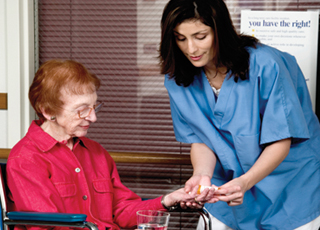
The assisted living industry should look to the skilled nursing industry for standards that could be implemented to help improve resident care and operators’ bottom lines, said the authors of an editorial published in the February issue of JAMDA, the Journal of Post-Acute and Long-Term Care Medicine.
“We emphatically do not argue for the replication of NH regulation in AL; rather, we advocate for a thoughtful review of NH standards that have proven effective and cost-effective, with an eye toward applicability in AL communities,” wrote Paul R. Katz, M.D., CMD, professor and chairman of the Department of Geriatrics at Florida State University; Alan Kronhaus, M.D., co-founder and CEO of Doctors Making Housecalls; and Steven Fuller, D.O., Ph.D., vice president and corporate medical director of Dillsburg, PA-based Presbyterian Senior Living.
“It’s time to recognize the need for national standards,” they said.
Minimum staffing ratios, mandatory dementia care training and “regulations that more clearly define both the clinical and administrative roles and responsibilities of AL physicians” should be high priorities, they write.
Also, it may be time for all assisted living communities to have a position similar to nursing home medical director, the doctors wrote. “Physicians expert in PA/LTC are in an ideal position to effect positive change in AL communities,” they added.
Whether such physicians are paid via salary, fee-for-service or some other method, the three authors wrote, “We believe that the cost attributed to the creation of such a position will be covered many times over through enhanced quality of care, resident satisfaction, longer lengths of stay, higher occupancy rates, and reduced staff turnover.”
In another editorial in the same issue of the journal, three other authors wrote that although physicians have an important role in assisted living, “Our vision is more expansive, and recognizes the broader health care team and the possibility that leadership may come from a nonphysician professional.”
Nurses, activity professionals, occupational and physical therapists and social workers address the most common reasons that residents move into assisted living — dementia, safety issues, social issues, medication management and the need for assistance with activities of daily living, said Barbara Resnick, Ph.D., CRNP, the Sonya Ziporkin Chair in Gerontology at the University of Maryland School of Nursing; Josh Allen, RN, C-AL, vice president of compliance at Senior Resource Group; and Ed McMahon, Ph.D., vice president of quality at Sunrise Senior Living.
Physicians may not be on-site often enough to address resident care needs adequately, they said, and requiring them could add costs that push assisted living out of reach for some potential residents.
Room exists for at least one national standard for assisted living, however, the authors said.
“Increasingly, there is a focus on the use of the interdisciplinary team in the care of older adults,” they said. “Perhaps AL is the place we can truly make that happen by starting with a national requirement that focuses on the need for access to at least a core number of members of the interdisciplinary team in every AL setting.”



